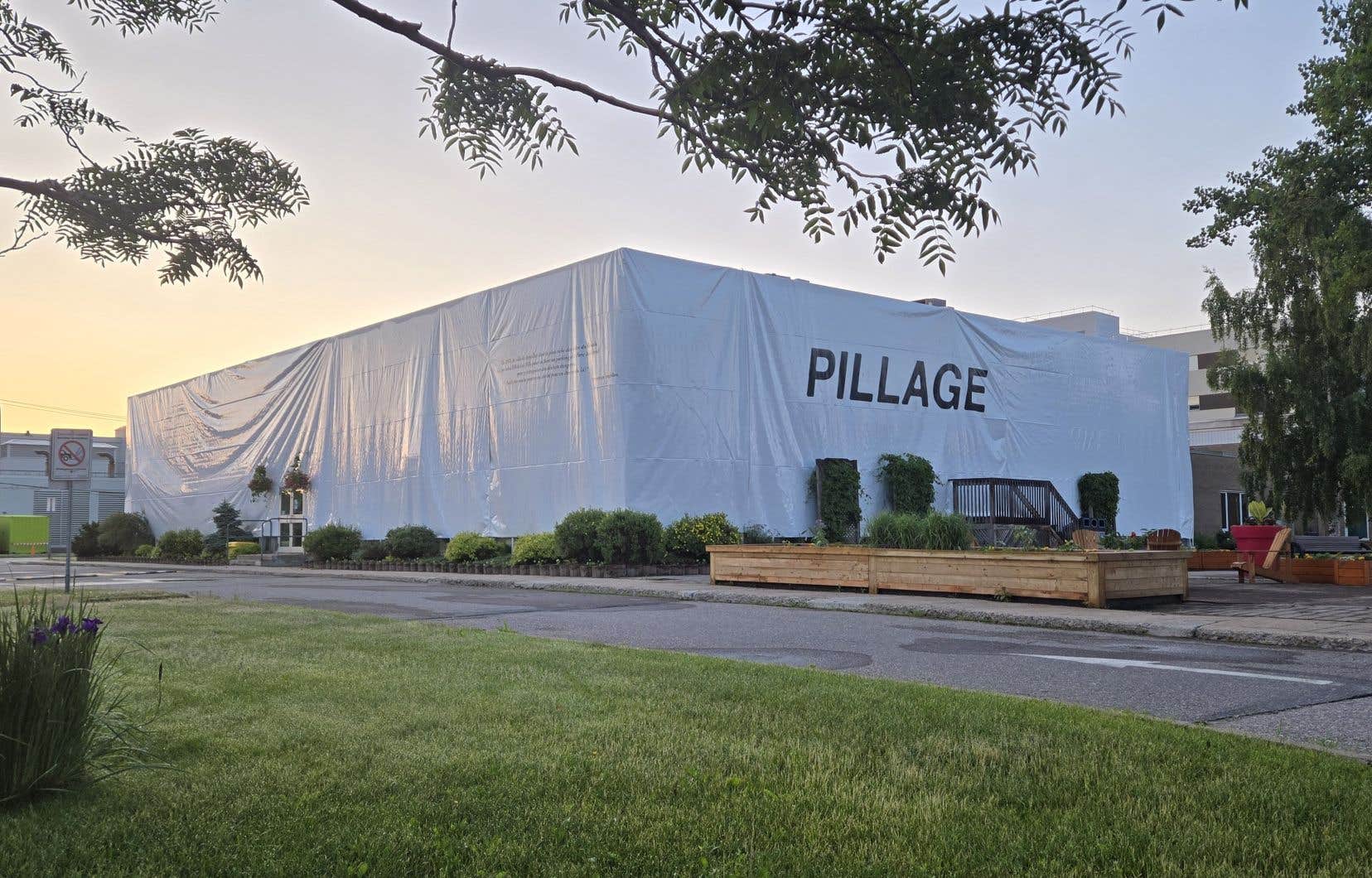The fight to preserve heritage in Quebec took an unusual form on the night of June 30 to 1er July. Faced with the announced demolitions, opponents have, since the 1970s, generally favoured means of action such as the formation of a defence group, petition, open letter, demonstration or request for classification against the dangers that the accelerated modernisation of the territory posed to the heritage of the past. In this regard, the mobilisation in favour of the preservation of the Van Horne house which stood on Sherbrooke Street in Montreal was fundamental.
In Sept-Îles, the city hall, a building dating from 1960, was surrounded by a large white tarpaulin displaying two messages. On one side, you can read: “PILLAGE.” On another: “In 1969, the city of Sept-Îles was the richest city in Canada. Now, they are selling the city hall to turn it into a parking lot and the industrial park to dump hazardous waste. You have to be poor in Christ to have reached this point.”
This dramatic action has rekindled a debate that, from Montreal, we believed to be closed since the sale of city hall to the Centre intégré de santé et de services sociaux de la Côte-Nord in April 2024 to turn it into a parking lot, as Jean-François Nadeau informed us in the pages of Duty. This intervention shows above all that the Septilien Mario Dufour, who is fighting for the preservation of this building, is less isolated than we thought. For years, this retired architectural technician has been multiplying approaches to the authorities in order to convince them not to give in to the pressure of the neighboring hospital which is seeking to enlarge its parking lot.
Alerted by Mario Dufour on 1er February 2021, Docomomo Québec, an organization dedicated to the study and preservation of modern architectural heritage, wrote to the then Minister of Culture and Communications (MCC) to ask her to consider classifying the building. Its superior heritage value had been recognized in May 2020 by the firm Patriarch as part of the heritage study commissioned by the City of Sept-Îles, on the advice of the MCC. In March 2021, the request was rejected on the main grounds that the building was too altered to benefit from such status.
It is true that the building has lost some of its original purpose, which made it much more than just a town hall. Composed of three buildings, it housed not only the municipal administration in the fully glazed wing, but also the fire and police stations as well as the municipal library, services that have since been located elsewhere.
The city used to be ambitious. In the 1950s, it hired Professor Harold Spence-Sales, a pioneer in land use planning, to develop a master plan to control the municipality’s rapid growth, and Affleck, Desbarats, Dimakopoulos, Lebensold, Michaud & Sise, a promising young architectural firm, to design its community centre.
Loss of authenticity of the building. Aging of the building. Need for car parking for patients and visitors to the nearby hospital. Are these reasons sufficient to erase a place that is emblematic in civic and architectural terms of the city’s past?
Opinions are divided between experts and non-experts. The former deplore the demolition of a building complex of great architectural value. On the other hand, many Septiliens are tired of this issue; they want to turn the page, as evidenced by the many reactions to the packaging of the town hall on social networks.
The large tarpaulin quickly disappeared. It took municipal employees only a few hours to take it down, and this was on a public holiday. The mayor is categorical: this “deplorable” action, this “vandalism”, will not change the decision taken in any way.
The action borrows its modus operandi more from the environmental struggle than from the fight for heritage. It should be noted that, to our knowledge, the packaging did not damage the building in any way. Let us underline the audacity and incredible organization of the citizens who thus demonstrated their opposition not only to the demolition of the city hall, but also to the establishment of a plant for the separation of rare earths, some of which are radioactive, in the Vigneault industrial park. It should be noted that this intervention preceded the conference given by the head of the marketing department of Métaux Torngat, the promoter of the industrial project, on Wednesday, July 3 at the Sept-Îles Chamber of Commerce, in order to convince Septiliens of the benefits of the project.
